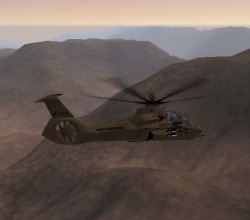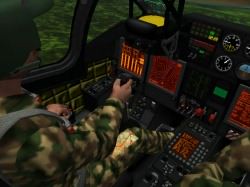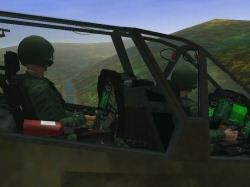|
Enemy Engaged: Comanche vs. Hokum Interview by Leonard "Viking1" Hjalmarson December 16, 1999 |
||||
|
An interview with Kevin Bezant of Razorworks, with assistance from Dave Lomas (AI) and Todd Gibbs (flight models). Please note that the terrain and buildings are still work-in-progress. Some time back Razorworks released Apache-Havoc, simulating the AH-64 Apache/Mi- 28 Havoc combination. These two choppers represent the best of the operational helicopter technologies of the American and former Soviet-bloc countries. At the time of release we were informed that an interoperable simulation of the Comanche-Hokum duo would follow. As we near that date more information has become available, and the Razorworks crew consented to this interview. Q. Thanks for taking the time! Can you introduce yourselves and tell us a bit about your background as it relates to PC simulations? A: We're Razorworks, based in Oxford, England. We are currently developing Comanche Hokum as a successor to Apache Havoc. Previously some of us worked for Digital Integration on titles such as Tornado, Apache Longbow and Hind. Q. C-H includes not only new gunships but also new theatres. What are the primary differences between the Comanche/Apache and the Havoc/Hokum? What difference does this imply for tactics? A: The main feature of the Comanche is the stealth technology. I've read that in a full stealth configuration (gun stowed, gear raised, bay doors closed and no stub wings attached) that the radar signature of the Comanche is 1/600th of that of a single Hellfire missile! Tactically, this means that the Comanche should excel at Scout and Recon missions. The Comanche has been designed to be 'mission agile' and can be configured for attack/precision strike missions. The Comanche has all glass cockpits (the pilot and co-pilot cockpits are identical - the pilot sits in the forward seat).
 The Hokum is a very different beast to the Havoc, the most obvious features being the co-axial main rotor configuration and the side-by-side crew seating arrangement. The Hokum's cockpit is more modern than the Havoc's having more multi-functional displays and a few standby instruments. There is a lot of rivalry between the manufacturers. Kamov claim that the Hokum is more manoeuvrable than the Havoc and the side-by-side seating arrangement helps with communication whilst Mil claim that the co-axial rotor arrangement of the Hokum is disastrous for combat helicopters (the blades can clash in high-g manoeuvres) and that the seating arrangement restricts the pilot's view. They also say that the ejector seat system in the Hokum is of little practical use because the discarded rotors are likely to damage other gunships in the formation. Tactically, the Hokum probably wins on an ease of use basis but I'd agree with Mil and say the pilot's view is more restrictive. |
 Q. The virtual cockpits are looking very, very good! Will there also be fixed cockpit views or have you gone exclusively 3d? A: The cockpits are exclusively 3D and therefore work at all permissible screen resolutions (those between 640x480 and 1600x1200 which have a square aspect ratio).
 Q. The animated crew looks to add a great deal to the immersion factor. Are these guys actually doing something or are they only there for show? That is, do they hit an appropriate button when I do? A: The animated crew do re-act to some stimuli such as the pilot's arms and legs move with the controls but they also 'freelance' a bit on the button pushing. If they reacted to the actual keypress then the delay would have been intolerable. There are some nice touches. The Hokum crew will lower their night vision goggles when they are in use and the Comanche crew's HIDSS (Helmet Integrated Display Sighting System) is actually projected on to the lenses. Initially we decided to include the crew because of the side-by-side seating in the Hokum, it would have looked very odd if they weren't there. Once the crew were in place we decided to bring them to life. Q. Tell us about the new campaign theatres. A: "Sword In The Sand" involves a bit of sabre rattling over a border dispute between Yemen and Saudi Arabia, "Task Force Lebanon" involves the US sending a task force into Lebanon and "War Of Independence" involves the Chinese invading their 'rebel' state. Q. When I spoke to you at E3 you mentioned the amount of work that was going into rebuilding the AI. Tell us about the difference this makes in wingman performance. A: A large percentage of the AI has been completely re-written for C-H making it a very different game to Apache-Havoc. During normal flight, wingmen will fly in formation with the flight leader and not just go racing off on their own as they did in A-H. This means that if you are the flight leader, your wingmen will follow you around and stay in formation with you. You will also be able to change formation during flight via the radio comms system. If you are not the flight leader however, then you will be expected to keep up with the rest of the group (but they may periodically wait for you if you lag behind). The most significant improvement in the AI for Comanche-Hokum is in the combat department. Your flight group will search their surroundings for places to hide, and bob-up and fire on your command. Buildings, bridges, forests and hills are some of the things that helicopters will use to mask themselves. Go to Page Two.
|
|||
|
Copyright © 1997 - 2000 COMBATSIM.COM, INC. All Rights Reserved. Last Updated December 15th, 1999 |
||||
